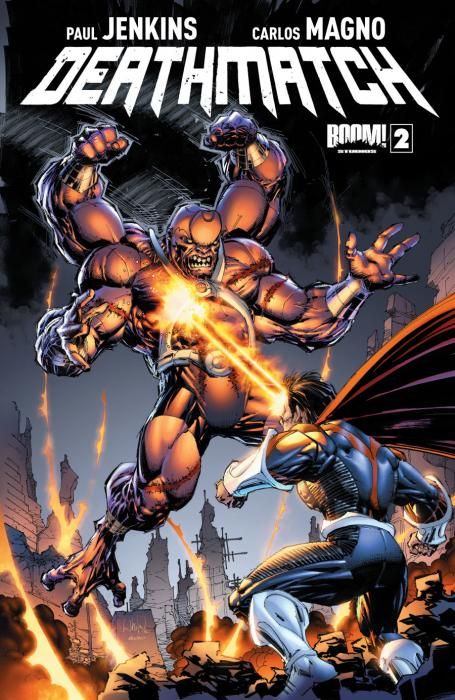"Deathmatch" #2 by Paul Jenkins and Carlos Magno delivers another surprisingly addictive installment of a closed-arena gladiatorial combat story of the type recently re-popularized by Suzanne Collins' "The Hunger Games."
It's an old, successful formula to have a story in which the reader can morbidly anticipate fictional deaths like a game of dominos, but Jenkins makes this now-overexposed setup new with the peculiar grace and ease of his world-building. As in "Deathmatch" #1, he begins the story mid-action and lets the reader absorb by context, largely avoiding information dumps. He is amazingly good at having his characters throw out casual references to likely-sounding events or phenomena. It's a conjuror's trick, how Jenkins smudges his characters and world around in a history of his own making until it becomes convincing facsimile of a shared superhero universe of great age and complexity.
The character guides in the back are fascinating along these same lines, because the reader can see Jenkins' character planning stretch even further back into invented history. Also, Jenkins' introduction of the "big chart" into the plot of "Deathmatch" #2 is a novel twist. Although hints or clues are common in this kind of "last one standing" story, I've never seen the combatants be presented with a match-by-match blueprint, and it will be interesting to see if this knowledge will affect characters' choices.
Magno's art is well-suited to "Deathmatch." His action sequences really get across the desperate, ugly struggles in the arena because of his textured line and merciless blow-by-blow closeups. His visual imagination is up to depicting the varied appearances and powers of Jenkins' huge cast, and he does a particularly good job in composing panels for the epic battle between Replic-8 and Sol Invictus. On the flipside, his pacing and composition is also effective in the "off-stage" interactions, especially Sable and The Rat's tense confrontation scene, which feels ominous and significant precisely because Magno keeps his this background uncluttered and deep with shadows.
As fellow reviewer Kelly Thompson mentioned in her analysis of the first issue, it's remarkable that Jenkins can make the reader care at all about these characters that didn't exist until a few months ago. It helps that most of the characters fall into recognizable types, but Jenkins is also very good creating distinct voices. Also, he lets the spotlight drift from one character to another at a seemingly natural pace.
The initial draw of "Deathmatch" is the stage, but almost all of its emotional force is in "off-stage" character interactions and dialogue. The cliffhanger ending of "Deathmatch" #2 is shocking and mysterious precisely because it happens in the less artificial, relatively safer "theatre wings" setting.
"Deathmatch" #2 maintains the narrative tension and rapid world-building of the debut issue, and the final matchup inches closer. However, it doesn't actually advance the central mystery of who, how and why very far. This isn't a serious problem for a second issue, but it draws out conflict and raises expectations for the ending. "The Hunger Games" started strong, but its pacing and the tightness of its plotting weakened as the trilogy progressed. Much of the payoff for "Deathmatch" will depend on whether Jenkins and Magno can deliver on motive as well as suspense.

